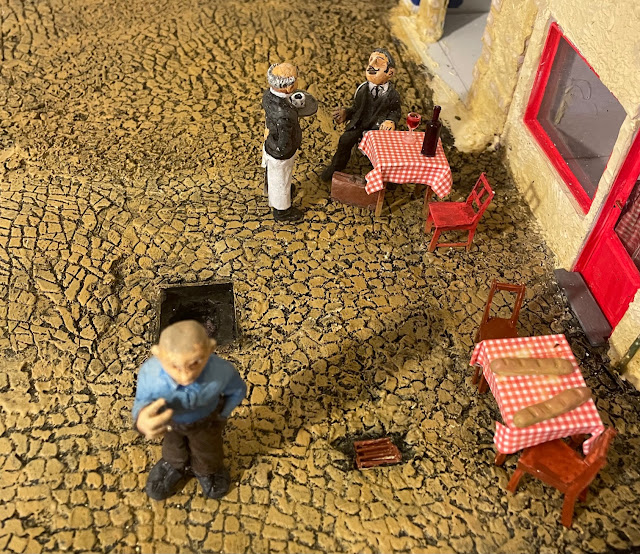Flying Fish and Making Streets
The little engines of the equally small narrow gauge Ferrovia di San Giorgio (F.S.G.) always seemed to huff and puff and sometimes wheeze their way up and down the 5 kilometers of Castello di San Giorgio vineyards to the tranquil fishing village of Amalfitano. Despite the sharp curves and steep hills some of the most treacherous trackage the FSG had to travel was the cobblestone streets of Amalfitano. Nothing was more dangerous than running into a cow or one of those new motor vehicles that started invading the village streets. Leonardo who drove the diesel "Topo" and his older brother Alessandro who drove the last remaining steam engine, "Pupo" kept an iron grip on the brake as they eased the throttle forward. They dreaded weaving their tiny little trains through the harbor where the plaza was surrounded by markets, stores and restaurants. Day and night there were always villagers and visitors shopping or lounging at the cafe. One time Alessandro was bringing the morning mixed train to pick up passengers and cargo from the morning ferries, when he received the biggest shock of his 47 year old life. Three carts full of fish lay stranded on the number one harbor track. Alessandro pulled on the whistle and then the bell as he slammed the emergency train brake into stop. He dropped sand on the rails hoping that he could stop in time but there was no time, he plowed through the three carts, sending chunks of fish flying everywhere. Chef Davide from the cafe shielded Signore Malatesta as a large fish head flew toward them. It took all morning to clean up the mess. The mixed train was late in leaving the harbor. Signore Malatesta had strong words for Alessandro when the morning mixed train finally arrived at the Castello di San Giorgio station nearly three hours late!
Making Streets
I decided to hand carve the cobblestone because I thought it would be the best way to get the kind of old world character cobblestone streets found in fishing villages. Rollers seemed too perfect, too structured for my tastes compared to the haphazard stone used in some of the villages I have seen in my travels through Italy and some parts of Europe and South America. So I used Durham's Water Putty because it dried rock hard and if I worked in small batches I would have enough time to carve the gazillion cobblestones that I needed to carve. So I first mixed the water putty into a slightly stiff mix and spread the mixture onto my layout table top.
The picture below shows cobblestones in between the track rails. This was scary. But the trick is to spread the water putty to below the rails so that when you are cleaning the track your not rubbing the paint off with your track rubber. The other trick is to mount a broken piece of hacksaw to a piece of wooden dowel. This little tool will let you carve out a thin slot on the inside rail for the train wheels. Be careful how deep you carve with it, you might just saw off the plastic spikes holding the rail. I use code 100 rail with slightly deep flange train wheels.
Carving the cobblestone was almost like a race against time to carve the water putty into cobblestone before the putty hardened. It dries really fast so it is key to only make small batches of water putty so you don't waste putty. The carving causes a lot of mess but I had a vacuum cleaner on hand to pick up all the waste putty. I thought of using the dremel but I was not interested in breathing the dust. No thanks.
The putty dried fast. I let it harden for a couple of hours before I started painting the cobblestones. I first painted the street using an old brush to paint it with diluted black paint to cover the cracks. After the black paint dried I followed it wit a dry brushing of a yellow ochre mix of paint. I lightly brushed the tops of the stones keeping mindful that I did not want to cover the black that was in the crevices. I then mixed a little white to the yellow ochre paint and even more lightly dry brushed random stones with the lighter color. Let dry for a couple of hours and you have an instant old world cobblestone street.
I am not done. I still need to install street lights, a Vespa, drains, manhole covers and water puddles. But that will have to wait for another story and a how to.








Comments
Post a Comment